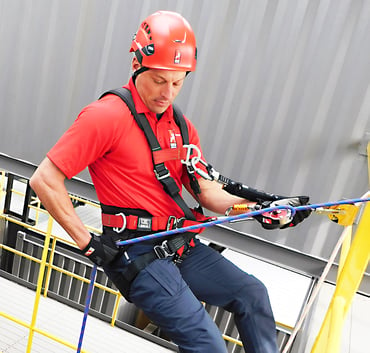Q&A: Replacing Your Rescue Harness
 READER QUESTION:
READER QUESTION:
How often should I replace my rescue harness?
ROCO TECH PANEL ANSWER:
We get many calls asking about the “life expectancy” of harnesses, rope, and other nylon products. Of course, many factors are involved, but a lot depends on how much you use your harness and how you use it.
First of all, NFPA 1858 10.1.2 states that “Software products shall be retired in accordance with 10.2.1 no more than 10 years from the date of manufacture.” Be sure to check the label of your harness, which should tell you when it was manufactured. If it’s beyond this 10-year service life, we recommend that it be taken out of service.
The frequency of use can have significant impact to the service life of a harness.
ASTM F1740-96 (2018) Guide for Inspection of Nylon/Kernmantle Rope also recommends a 10-year service life for rope, which can be applied to a nylon harness as well. Section 5.5.2 states, “Retire any rope which is greater than ten years old, regardless of history and usage.”
 Here are a few examples based on industry use. The fall protection industry generally recommends 2 to 3 years as a service life for a harness or belt in regular use. The Climbing Sports Group of the Outdoor Recreation Coalition of America states that a climbing harness should last about 2 years under normal weekend use. The military uses 7 years as a service life for nylon products. Of course, hard use of any product would call for a shorter service life than would normally be expected. Also, the frequency of use can have significant impact to the service life of a harness. It is not only the continual wear and tear a harness receives during use, but the exposure to other factors that exacerbate the degradation of textile fibers such as UV, sweat, or potentially other airborne chemicals. Frequent and rigorous use of a harness could decrease the service life substantially.
Here are a few examples based on industry use. The fall protection industry generally recommends 2 to 3 years as a service life for a harness or belt in regular use. The Climbing Sports Group of the Outdoor Recreation Coalition of America states that a climbing harness should last about 2 years under normal weekend use. The military uses 7 years as a service life for nylon products. Of course, hard use of any product would call for a shorter service life than would normally be expected. Also, the frequency of use can have significant impact to the service life of a harness. It is not only the continual wear and tear a harness receives during use, but the exposure to other factors that exacerbate the degradation of textile fibers such as UV, sweat, or potentially other airborne chemicals. Frequent and rigorous use of a harness could decrease the service life substantially.
Even how and where you store your gear is an important factor. In an industrial environment, for example, atmospheric exposures may be a key consideration for nylon products even while in storage. Storage conditions, heat, light, temperature, and other variables can all impact nylon. NFPA 1858 Section 9.2 references the storage of life safety rope and other nylon products, “Equipment shall be stored in such a manner as to prevent damage contact with other equipment and to prevent exposure to chemicals and atmospheres that can contribute to rust, corrosion, or oxidation.”
How and where you store your gear is also an important factor.
As with all of your rescue gear, it’s very important to account for each use and follow the manufacturer’s instructions for care, use and inspection. As with ropes, if your harness has been subjected to shock loads, fall loads, abuse other than normal use, or fails the inspection for any reason, it should be removed from service and destroyed.
Bottom line…Never take chances when there’s any doubt about the serviceability of a life safety product. It’s simply not worth the risk.




